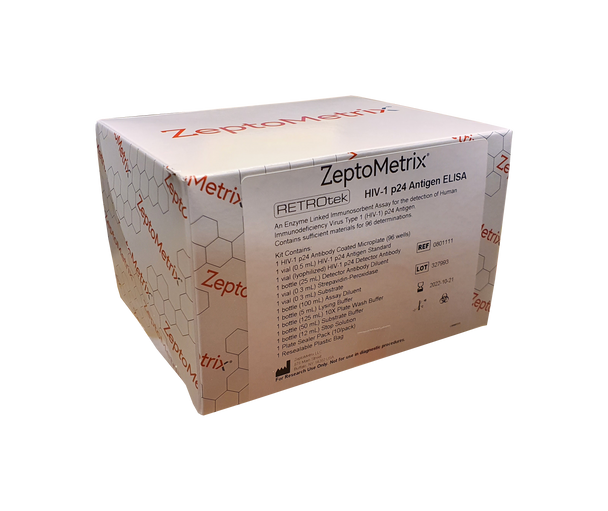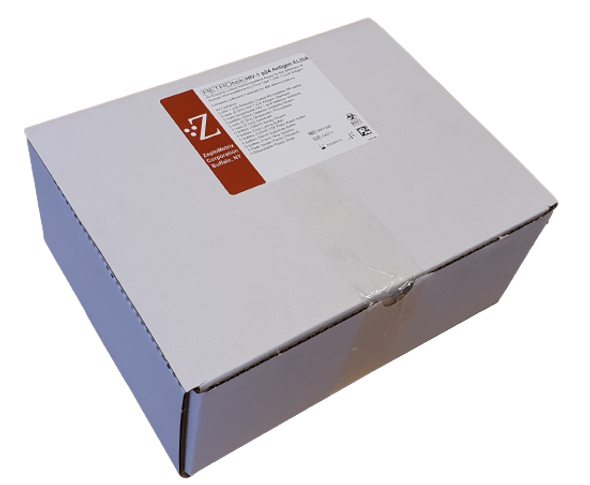Description
The RETRO-TEK HIV-1 p24 Antigen ELISA is supplied for research purposes only. It is not intended for use in the diagnosis or prognosis of disease, or for screening and may not be used as a confirmatory test in diagnostic situations.
The RETRO-TEK HIV-1 p24 Antigen ELISA is an enzyme linked immunoassay used to detect Human Immunodeficiency Virus Type 1 (HIV-1) p24 antigen in research specimens, including cell culture media, as well as human sera and plasma. It can also be used to monitor the purification and biochemical behavior of HIV-1.
Furthermore, the assay may augment or supplant reverse transcriptase measurements traditionally employed to detect the presence of HIV-1. Such enzymatic measurements are not HIV-1 specific.
The RETRO-TEK HIV-1 ICx/CRx Kit (ZEPTOMETRIX Catalog #: 0801096) for immune complex dissociation and confirmation of p24 reactivity enhances the detection of p24 antigen in serum or plasma.
Many specimens contain HIV-1 viral loads greater than the range of the standard curve of this assay. The RETRO-TEK HIV-1 p24 Extended Range ELISA (ZEPTOMETRIX catalog # 0801137) will extend the standard curve of this assay to 4 ng/ml.
Zeptometrix | 0801111 | HIV-1 p24 Antigen ELISA Datasheet
Zeptometrix | 0801200 | HIV-1 p24 Antigen ELISA Datasheet
PRINCIPLE OF THE TEST
Microwells are coated with a monoclonal antibody specific for the p24 gag gene product of HIV-1. Viral antigen in the specimen is specifically captured onto the immobilized antibody during specimen incubation. The captured antigen is then reacted with a high-titered human anti-HIV-1 antibody conjugated with biotin. Following a subsequent incubation with Streptavidin-Peroxidase, color develops as the bound enzyme reacts with the substrate. Resultant optical density is proportional to the amount of HIV-1 p24 antigen present in the specimen.
REAGENTS
Materials Supplied:
• HIV-1 p24 Antibody Coated Microplate for 96 determinations,1 plate: 12x8 well strips.
• HIV-1 p24 Detector Antibody, 1 vial, lyophilized: Contains biotin-labeled human antibody to HIV-1, human source material non-reactive for antibodies to HIV-1 and non-reactive for HIV-1 p24 antigen, milk, Triton X-100®, Tween 20®, and PBS.
• Detector Antibody Diluent: 25 ml
• HIV-1 p24 Antigen Standard, 0.5 ml: Contains detergent-disrupted, heat-inactivated viral antigen, goat serum, Triton X-100®, and sodium azide.
• Lysing Buffer, 5 ml: Triton X-100® in PBS and 2-chloroacetamide.
• Streptavidin-Peroxidase, 0.3 ml: Contains streptavidin conjugated to horseradish peroxidase, PBS, goat serum, and 2-chloroacetamide.
• Assay Diluent, 100 ml: Contains goat serum, PBS, Triton X-100®, and 2-chloroacetamide.
• 10X Plate Wash Buffer, 125 ml: Contains PBS, Tween 20®, and 2-chloroacetamide.
• Substrate, 0.3 ml: Contains tetramethylbenzidine (TMB), and dimethyl sulfoxide (DMSO).
• Substrate Buffer, 50 ml: Contains citrate/acetate buffer, hydrogen peroxide, and 2-chloroacetamide.
• Stop Solution, 12 ml: Proprietary formulation.
• Plate Sealers: 10
• Resealable Plastic Bag: 1
® Triton X-100 is a registered trademark of Union Carbide Chemicals and Plastics Co., Inc. Tween 20 is a registered trademark of Imperial Chemical Industries.
Materials required but not supplied:
• Disposable gloves
• Validated adjustable micropipettes, single and multichannel
• Test tubes and racks for preparing specimen and control dilutions
• Graduated cylinders and assorted beakers
• Validated automatic microplate washer or manual vacuum aspiration equipment
• Validated incubator for 37°C ±1°C
• Validated microplate reader
• Timer
• 1% sodium hypochlorite as disinfectant. May be prepared from household bleach
• Distilled or deionized water
STORAGE
Store all kit reagents at 2° - 8°C. DO NOT FREEZE. When stored properly the kit is stable until the date indicated on the box label.
PRECAUTIONS
• Prior to performing the assay, carefully read all instructions.
• Use universal precautions when handling kit components and test specimens.*
• To avoid cross-contamination, use separate pipette tips for each specimen.
• When testing potentially infectious specimens, adhere to all applicable local, state and federal regulations regarding the disposal of biohazardous materials.
• HIV-1 p24 Antigen Standard contains sodium azide as a preservative. Sodium azide may react with lead or copper pipes to form explosive metal azides. Flush pipes with large quantities of water upon disposal to prevent azide buildup in drains.
• Stop Solution contains hydrochloric acid which may cause severe burns. In case of contact with eyes or skin, rinse immediately with water and seek medical assistance. Wear protective clothing and eye wear.
• Human source material used in the manufacture of the HIV-1 Detector Antibody has been tested and found negative for Hepatitis B surface antigen. The viral lysate used to prepare the HIV-1 p24 Antigen Standard has been inactivated by chemical disruption and heating. Handle these reagents as if capable of transmitting infectious agents.
**MMWR, June 24, 1988, Vol. 37, No. 24, pp. 377-382, 387-38
PREPARATION OF REAGENTS
HIV-1 p24 Detector Antibody: Add 11.0 ml of Detector Antibody Diluent to the bottle of HIV-1 p24 Detector Antibody. Mix or rock gently for at least 1 hour. Reconstituted reagent can be stored for one week at 2 - 8°C. Alternatively, the reconstituted HIV-1 p24 Detector Antibody can be divided into aliquots and frozen at -20°C until the expiration date of the kit.
HIV-1 p24 Antigen Standard: Prepare a series of six standards from the HIV-1 p24 Antigen Standard. Use the dilution scheme in Table 1. Any diluted HIV-1 p24 Antigen Standard remaining after the completion of the assay should be disinfected and discarded. Do not save diluted reagent.
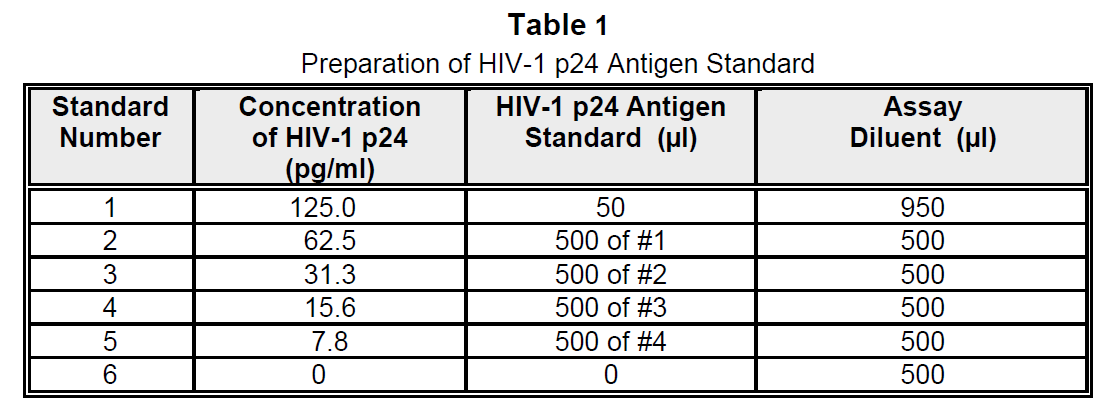
Streptavidin-Peroxidase and Substrate: To prepare the Streptavidin-Peroxidase Working Solution and the Substrate Working Solution, use the dilution schemes in Table 2. Use Substrate Working Solution within 15 minutes of its preparation. Any diluted Substrate Working Solution and Streptavidin-Peroxidase Working Solution remaining after the completion of the assay must be discarded.

Plate Wash Buffer: Dilute 10X Plate Wash Buffer 1:10 in distilled or deionized waterprior to use. 1X Plate Wash Buffer may be stored at 2° - 8°C for up to 1 week. Additional bottles of 10X Plate Wash Buffer (ZEPTOMETRIX Catalog #: 0801060) may ordered.
TEST PROCEDURE
When assaying serum or plasma samples, sensitivity may be increased by using the RETRO-TEK HIV-1 p24 ICx/CRx Kit, (ZEPTOMETRIX Catalog #: 0801096) to dissociate possible immune complexes. Reactive specimens should be confirmed using the ICx/CRx Kit confirmatory reagents.
Allow all reagents to reach room temperature before use. Label test tubes to be used for the preparation of standards and specimens. Label each strip on its end tab to identify the strips should they become detached from the plate frame during the assay. If the entire 96 well plate will not be used, remove surplus strips from the plate frame. Place surplus strips and desiccant into the Resealable Plastic Bag, seal and store at 2° - 8°C.
- Step 1: Treat specimens in a test tube by pipetting 50 µl of Lysing Buffer into 450 µl specimen and mix well.
- Step 2: Wash each well of the microplate or the selected number of strips 6 times with 300 µl of 1X Plate Wash Buffer and aspirate. Thoroughly blot by striking inverted microplate or strips on a pad of absorbent towels. Continue striking until no droplets remain in the wells. Do not allow washed plates to dry completely prior to sample addition. Drying will adversely affect test results.
- Step 3: Leave one well of the microtiter plate empty during the assay. This well is used for a substrate blank. Pipette 200 µl of standards #1-6 into duplicate wells.
- Step 4: Pipette 200 µl of each specimen, as prepared in Step 1, into duplicate wells.
- Step 5: Cover microplate with a plate sealer and incubate as follows:
a. Overnight at 37°C ± 1°C, for serum or plasma specimens treated with RETRO-TEK HIV-1 ICx/CRx Kit.
b. Two hours or overnight at 37°C ± 1°C, for untreated serum or plasma, culture fluids or other biological specimens. - Step 6: Aspirate and wash plate as described in Step 2.
- Step 7: Pipette 100 µl of reconstituted HIV-1 p24 Detector Antibody into each well, except the substrate blank. Cover the microplate with a sealer and incubate for 1 hour at 37°C ± 1°C.
- Step 8: Aspirate and wash plate as described in Step 2.
- Step 9: Pipette 100 µl of the Streptavidin-Peroxidase Working Solution into each well except the substrate blank. Cover the microplate with a sealer and incubate for 30 minutes at 37°C ± 1°C.
- Step 10:Aspirate and wash plate as described in Step 2.
- Step 11: Pipette 100 µl of Substrate Working Solution into all wells and incubate uncovered for 30 minutes at room temperature (18°- 25°C). A blue color will develop in wells containing viral antigen.
- Step 12:Stop the reaction by pipetting 100 µl of Stop Solution into each well. A color change from blue to yellow will result.
- Step 13:Within 15 minutes, read the optical density of each well at 450 nm using a microplate reader.
TEST VALIDITY
Determine the mean optical density values for each standard and specimen. For the test to be valid, it must meet the following criteria:
• The mean optical density of the 0 pg/ml standard and the substrate blank must be less than 0.200.
• The mean optical density of the 62.5 pg/ml standard must be greater than or equal to 0.500
Additional Validity Requirements for the RETRO-TEK HIV-1 ICx/CRx Kit
• For immune complex dissociation, the positive control must be above the cut-off for immune complex dissociated specimens and the negative control must be below the cut-off for immune complex dissociated specimens.
• After treatment with the CRx Neutralization Reagent, the level of the Positive Control must be reduced by at least 50% and the level of the Negative Control must be below the cut-off.
CALCULATION OF RESULTS
Determination of the Cutoff Value:
A predetermined factor is added to the mean of the negative control or negative specimen sample optical value.
• For non-immune complex dissociated serum or plasma samples, and tissue culture samples add 0.030.
• For immune complex dissociated serum or plasma samples add 0.050.
The values above are general guidelines to determine the cutoff value. Alternatively, more accurate results may be obtained by adding at least two standard deviations to the mean optical density from a set of known negative specimen samples to establish the statistical cutoff value.
Samples with absorbance values greater than or equal to the cutoff value are considered positive. Positive results must be confirmed by retesting in duplicate from the same sample source.
Specimens found to be repeatedly reactive for p24 should be confirmed using the CRx Neutralization Procedure. Refer to Catalog #0801096 (RETRO-TEK ICx/CRx Kit). For confirmation of reactivity by the RETRO-TEK ICx/CRx Kit, calculate the percent reduction of p24 reactivity in controls and specimens using the formula in Figure 1:
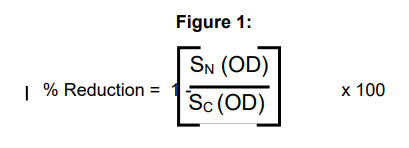
Reactivity is confirmed by a reduction of p24 antigen in the specimen by 50% or greater. If reactivity is not confirmed, the specimen is considered indeterminate.
To Quantitate Levels of HIV-1 p24:
Using linear graph paper, plot the concentration of HIV-1 p24 Antigen Standard (pg/ml) on the X-axis versus the mean optical densities for each standard on the Y-axis. Then determine the concentration of HIV-1 p24 antigen in specimens by interpolation from the standard curve. Alternatively, the level of HIV-1 p24 may be calculated by computer using a point-to-point algorithm. Be sure to correct for all dilutions, including the 1 to 1.1 dilution made during the addition of Lysing Buffer.
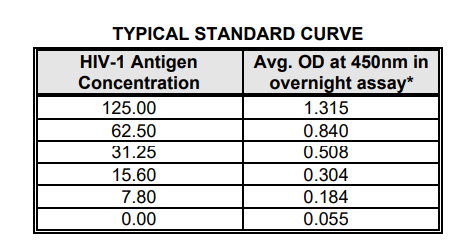
*2 hour assay values may be less than the overnight results. Standard curves may vary as a result of incubation time and temperature, laboratory temperature, etc.
LIMITATIONS OF THE PROCEDURE
Most HIV-1 infected individuals produce antibodies to p24 antigen. The concentration and microspecificity of these antibodies will vary from individual to individual and from bleed to bleed. The observed level of p24 antigen in any specimen containing p24 antibodies may be affected by the following:
• Host antibodies may mask the epitope reactive with capture MAb. Consequently, the optical density may be reduced.
• Host antibodies may mask epitopes that bind to the detector antibody, again reducing the optical density.
After immune complex dissociation and neutralization, host antibodies may recombine with p24 antigen. The recombination of host antibody with antigen is competitive with the capture of p24 by the MAb on the solid phase and thus may mask some of the p24. The rate of recombination is determined by the concentrations of p24 antigen and anti-p24 antibodies, the affinity of the antibodies, as well as temperature and time and is therefore difficult to control. Correlation of results for specimens between repeat test runs and among kits from different manufacturers may be adversely affected by such competitive recombination.
3 Reviews
-
Fast delivery
It was unexpectedly fast delivery. The service was very efficient in just a short amount of time.
-
Eccellente
Tutti gli articoli e le amministrazioni offerte dall'azienda sono estremamente preziosi. Ottimo lavoro Gentauro. Ben fatto.
-
mejor calidad
El antibiótico fue de muy alta calidad, muy efectivo y sin efectos secundarios.

